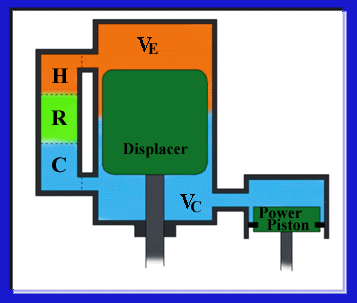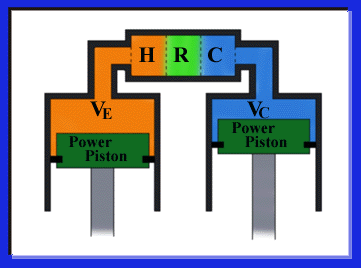
Structure of the Stirling engine
 Japanese
Japanese
Stirling cycle output power by repeating constant volume heating process, isothermal expansion process, constant volume cooling process, and isothermal compression process. It can't do it in fact to do this with one piston. Therefore, with a general Stirling engine, there are the two space that a temperature difference is attached and approximately realize these processes by making gas go and return between these space. A movement of such a gas is done by a displacer piston with a displacer type Stirling engine, and by two power pistons with 2 piston type Stirling engine.
In case that high-temperature space and cooling space is directly heated, heat transfer area can't take it widely. Therefore, with an more actual engine, a heater and a cooler are installed, and make the gas to pass through a heater flow in high-temperature space and make the gas to pass through a cooler flow in cooling space .
A regenerator stores heat, when working gas goes and returns between high-temperature space and low temperature space. In case that an efficiency of a regenerator is 100 %, an ideal efficiency of Stirling engine is equal to an efficiency of Carnot cycle.

Model of a general Stirling engine
VE : High temperature(Expansion) space
H : Heater
R : Regenerator
C : Cooker
VC : Low temperature(Compression) space
Structure of the Displacer type Stirling engine
Å@With a displacer type Stirling engine, a working gas is moved between a high-temperature space and low temperature space by a displacer piston. The pressure variation to rise from this is output as power to the outside by a power piston. There are two styles of displacer type Stirling engines, and these are named with beta typeand the gamma type.
 Structure of the beta type Stirling engine
Structure of the beta type Stirling engine
In a beta type Stirling engine the displacer and power piston share a single cylinder. Therefore, a displacer piston and power piston is supposed to have a bore of the same diameter. By overlaping between each movement of both pistons, a compression ratio of the engine raises and can obtain higher output than gamma type Stirling engine. However, the shaft of the displacer and the power piston are on the same axis, therefore driving mechanism gets complicated.

 Structure of the gamma type Stirling engine
Structure of the gamma type Stirling engine
In the gamma type Stirling engine, the cylinder for a displacer piston and the cylinder for the power piston are separately arranged. Compared with beta type, the mechanism is simple, and adjustment of the compression ratio and increasing heat transfer area are comparatively easy. This type of engine is well suited for low temperature time difference Stirling engines.

Structure of the 2-piston type Stirling engine
2 piston type Stirling engines are one of 3 fundemental styles of Stirling engines and are called alpha type Stirling engines. This type of engine has two power pistons at a phase difference of 90 deg. There is a high temperature ( expansion ) space and low temperature ( compress ) space attached to each other. As the two pistons make the gas between both spaces go and return, the same two pistons output power.



 Return to Stirling Engines of Saitama University
Return to Stirling Engines of Saitama University
 Return to Stirling Engiene Home Page Academic Edition
Return to Stirling Engiene Home Page Academic Edition


 Japanese
Japanese
 Structure of the beta type Stirling engine
Structure of the beta type Stirling engine
 Structure of the gamma type Stirling engine
Structure of the gamma type Stirling engine



 Return to Stirling Engines of Saitama University
Return to Stirling Engines of Saitama University Return to Stirling Engiene Home Page Academic Edition
Return to Stirling Engiene Home Page Academic Edition